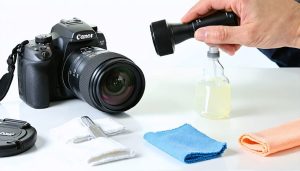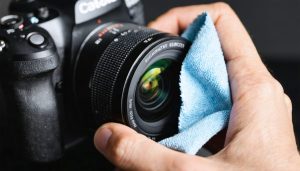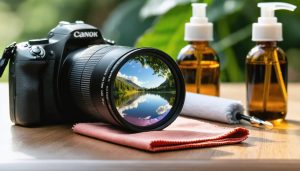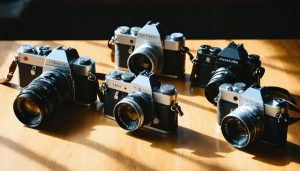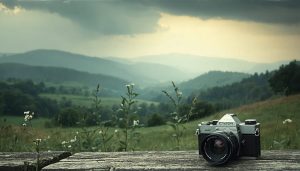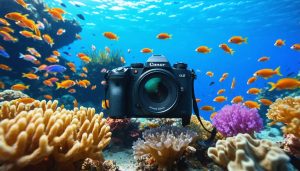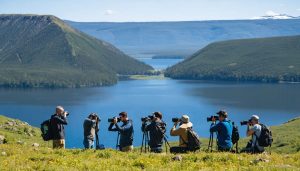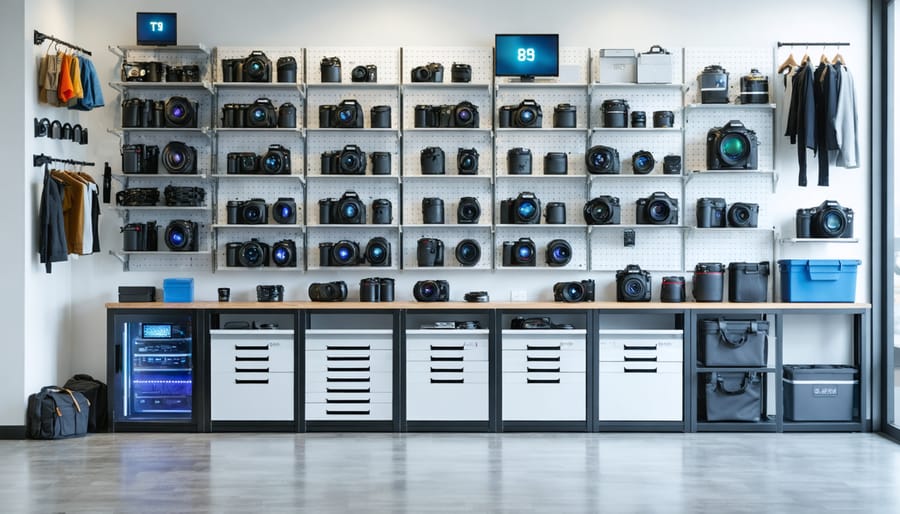
Protecting thousands of dollars worth of photography gear demands more than just tossing equipment into a closet. Every lens, camera body, and accessory requires strategic storage to prevent dust accumulation, moisture damage, and unnecessary wear. Professional photographers understand that proper storage directly impacts both equipment longevity and shoot-ready accessibility.
Consider your gear storage system as important as the equipment itself. Whether you’re managing a compact mirrorless setup or an extensive DSLR collection, thoughtful organization prevents costly repairs and ensures every piece of equipment remains in pristine condition. The right storage solution transforms chaos into efficiency, turning your workspace into a professional studio where every item has its place.
From climate-controlled cabinets to customized hard cases, your storage choices determine how well your investment retains its value. Smart storage isn’t just about protection—it’s about creating a workflow that keeps you shooting instead of searching for equipment. With photography gear prices constantly rising, proper storage has become an essential aspect of professional equipment management, not just an optional luxury.
Let’s explore how to create a storage system that protects your gear while keeping it readily accessible for your next creative endeavor.
The Foundation: Choosing the Right Storage Environment
Temperature and Humidity Control
Temperature and humidity are two of the biggest enemies of your valuable photography gear. The ideal storage environment should maintain a temperature between 65-75°F (18-24°C) with relative humidity levels between 35-45%. Fluctuations outside these ranges can lead to fungal growth on lenses, corrosion of electronic components, and deterioration of camera bodies.
To maintain optimal conditions, consider using a dry cabinet or dehumidifier in your storage area. Dry cabinets are especially popular in humid climates, using electronic humidity control to keep your gear safe. If a dry cabinet isn’t in your budget, silica gel packets are an excellent alternative – just remember to recharge or replace them every few months.
Never store your equipment in basements, attics, or garages where temperature and humidity can swing dramatically. These environments are particularly risky during seasonal changes. Instead, choose a climate-controlled room in your living space, away from direct sunlight and external walls.
For those living in particularly humid regions, consider using humidity indicators in your storage containers. These inexpensive tools can alert you to dangerous moisture levels before they damage your gear. Additionally, running a small fan in your storage area can help prevent stagnant air and reduce the risk of mold growth.
Remember to always let your gear acclimate when moving between environments with different temperatures to prevent condensation from forming on and inside your equipment.
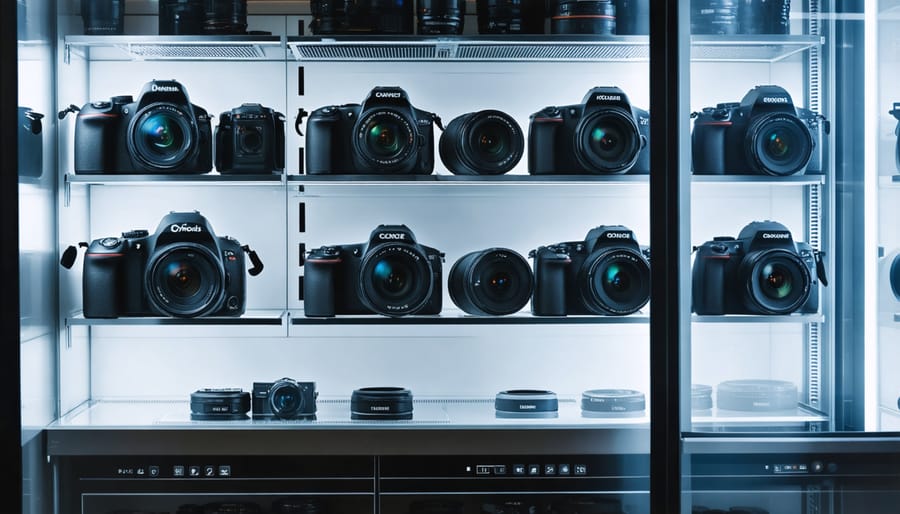
Light and Dust Protection
Light and dust are two of photography gear’s biggest enemies, capable of causing significant damage over time if not properly managed. UV light can gradually deteriorate camera bodies, fade LCD screens, and potentially damage sensitive electronic components. Meanwhile, dust accumulation can wreak havoc on lenses and sensors, leading to spotty images and potentially costly repairs.
To protect against light damage, store your gear in opaque cases or bags that block UV rays. If using clear storage solutions, keep them away from direct sunlight and consider using UV-protective filters on windows in your storage area. For additional protection, use silica gel packets in your storage containers to control humidity levels, which can exacerbate light-related deterioration.
Dust protection requires a multi-layered approach. Start by keeping gear in airtight cases or bags when not in use. Regular maintenance is crucial – implement professional lens cleaning techniques to prevent dust buildup. Consider using a dedicated cleaning station in a well-ventilated area away from potential dust sources.
For long-term storage, invest in weather-sealed cases with rubber gaskets. These provide excellent protection against both dust and light while maintaining a stable internal environment. Remember to periodically air out your gear and check for any dust accumulation or light damage, especially if stored for extended periods.
Storage Solutions for Different Spaces
Home Studio Solutions
Creating a dedicated space for your photography gear at home doesn’t require a complete studio renovation. Whether you have a spare room or just a corner to work with, there are numerous creative display solutions that can transform your space into an efficient storage hub.
For those with a dedicated room, consider installing adjustable shelving systems along the walls. These allow you to customize spacing based on your equipment size and can be modified as your collection grows. Industrial-grade metal shelving units offer excellent stability for heavier gear, while wooden shelves can add a warm, aesthetic touch to your space.
Cabinet solutions are particularly effective for dust protection. Look for units with adjustable dividers and soft-close drawers to prevent vibration damage. Climate-controlled cabinets are worth the investment for protecting sensitive equipment from humidity and temperature fluctuations. Consider adding silica gel packets inside cabinets for extra moisture protection.
Make use of vertical space by installing pegboards or slat walls for hanging accessories like straps, cables, and smaller items. Under-shelf drawers can maximize storage capacity without taking up additional floor space. For those working with limited room, rolling storage carts offer mobility and can be tucked away when not in use.
Remember to position your storage solutions away from direct sunlight and heat sources, and ensure proper ventilation to prevent moisture buildup. Label everything clearly to maintain organization and quick access to your gear.
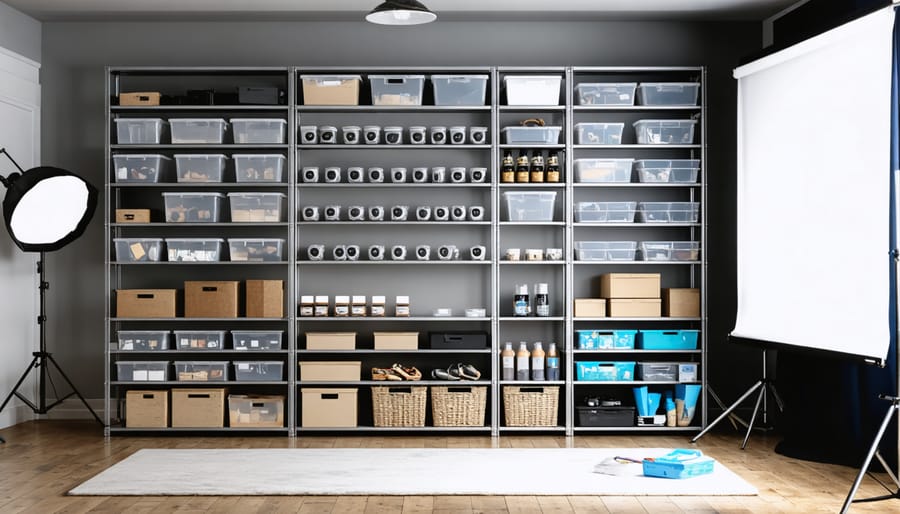
Small Space Solutions
Living in a small space doesn’t mean you have to compromise on your photography gear storage. With some creative thinking, you can maximize every inch of available space while keeping your equipment safe and accessible.
Vertical storage solutions are your best friends in tight spaces. Consider installing wall-mounted pegboards where you can hang cameras, lenses, and accessories using specialized hooks. These systems are highly customizable and can evolve with your growing collection.
Make use of over-the-door organizers, typically used for shoes, to store smaller items like filters, batteries, and memory cards. Clear pocket organizers make it easy to spot what you need quickly. Under-bed storage containers with dividers are perfect for rarely-used equipment or seasonal gear, while keeping dust at bay.
Transform a small closet into a dedicated gear station by installing adjustable shelving and drawer systems. Use foam-lined containers to protect delicate equipment, and label everything clearly. If space allows, mount a small desk lamp for equipment inspection and cleaning.
Multi-functional furniture is another smart solution. Look for ottomans with storage compartments, coffee tables with drawers, or bed frames with built-in storage. Consider mounting a floating desk that can double as a workstation and gear prep area.
Remember to maintain proper ventilation and temperature control in your storage area, even in small spaces. A compact dehumidifier can help protect your gear from moisture damage without taking up much room.
Mobile Storage Options
When you’re on location or traveling for shoots, protecting and organizing your gear becomes even more crucial. A well-thought-out mobile storage system ensures your equipment stays safe while remaining easily accessible.
Hard-shell camera backpacks offer excellent protection and organization for your essential gear. Look for models with customizable dividers, allowing you to create perfect-fit compartments for your specific equipment. Many modern camera bags also include dedicated laptop sleeves and digital storage solutions compartments for seamless workflow management in the field.
Pelican cases remain the gold standard for photographers who need maximum protection during travel. These waterproof, crushproof cases come in various sizes and feature customizable foam inserts that cradle your gear securely. While they’re heavier than soft cases, they’re invaluable for air travel or shooting in challenging environments.
For day shoots, consider rolling cases with telescoping handles. These combine the convenience of wheels with organized compartments, saving your back while keeping gear accessible. Many feature side access panels, letting you grab equipment quickly without unpacking everything.
Don’t forget about smaller organizational tools like lens pouches, battery wallets, and memory card cases. These accessories help maintain order within your larger bags and protect sensitive items from dust and moisture while on the move.
Organization Systems That Actually Work
Categorizing Your Gear
Organizing your photography gear effectively starts with logical categorization. Begin by grouping your equipment into primary categories: cameras, lenses, lighting equipment, and accessories. This basic framework makes it easier to locate specific items quickly and ensures similar items are stored together safely.
For cameras and lenses, consider creating subcategories based on use case or shooting scenario. Group portrait lenses together, keep wide-angle lenses in their own section, and maintain a dedicated space for specialty equipment like macro lenses. This approach helps you grab exactly what you need for specific shoots without rifling through everything.
Lighting equipment deserves its own dedicated zone, with flash units, continuous lights, and modifiers stored separately but nearby. Small accessories like triggers, cables, and batteries should have their own organizational system – clear containers or drawer organizers work wonderfully for these items.
Create a “go bag” section for frequently used gear, keeping your most essential items easily accessible. Consider implementing a color-coding system using labels or tags to identify different categories at a glance. Memory cards, filters, and cleaning supplies benefit from small, dedicated containers within their respective categories.
Remember to keep your most valuable and frequently used items in easily accessible locations, while storing rarely used specialty equipment in secondary storage areas. This tiered approach to categorization ensures efficiency while maintaining organization throughout your collection.
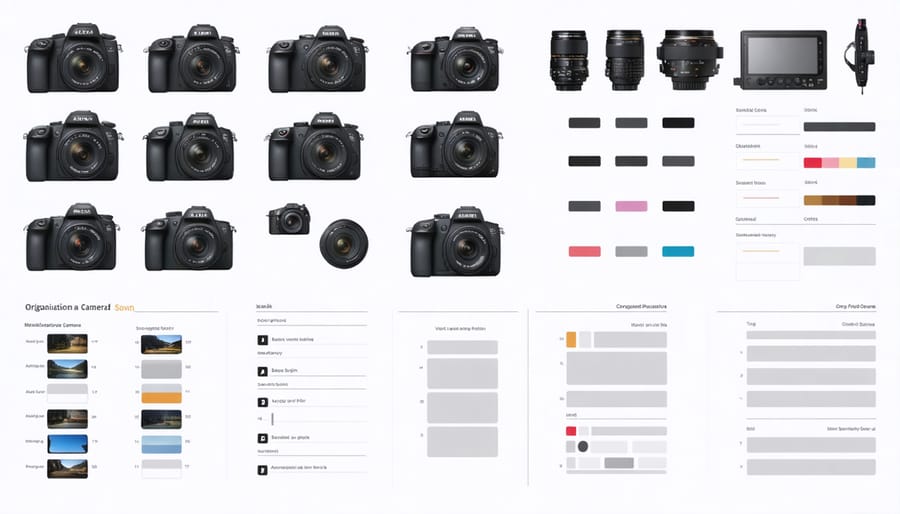
Labeling and Inventory Management
A well-organized labeling system is the backbone of effective gear management. Start by creating a unique identifier for each piece of equipment, combining letters and numbers that make sense to you. For example, “L24-70” for your 24-70mm lens or “FB01” for your first flash unit.
Use high-quality labels that can withstand frequent handling and won’t leave residue on your gear. Consider using a combination of physical labels and QR codes that link to detailed information about each item. This digital connection can help you track maintenance history, purchase dates, and warranty information.
Maintain a comprehensive inventory spreadsheet or use specialized photography gear management apps to track your equipment. Include essential details like serial numbers, purchase dates, insurance information, and current market value. Regular inventory checks help identify missing items and ensure your insurance coverage remains adequate.
Color-coding can add another layer of organization – use different colored labels or stickers to distinguish between categories like lenses, lighting equipment, or accessories. This visual system makes it easier to quickly identify and locate gear, especially in dim lighting conditions.
For rental equipment or gear you share with others, implement a check-out system. Track who has what equipment and when it’s due back. This prevents confusion and helps maintain accountability, especially in studio settings or when working with multiple photographers.
Quick Access Solutions
Setting up a quick access system for your photography gear can make the difference between capturing and missing the perfect shot. Start by arranging your most frequently used equipment in dedicated zones within arm’s reach of your workspace. Consider installing wall-mounted hooks or pegboards for cameras and frequently used lenses, ensuring they’re secure but easily grabbable.
Create a “go bag” system with pre-packed essential kits for different shooting scenarios. For instance, keep a street photography kit with your favorite prime lens, spare battery, and memory cards in one bag, and a separate event photography setup in another. This approach eliminates the need to hunt for gear when time is critical.
Implement a color-coding system using different colored tape or labels to quickly identify equipment categories. Red for prime lenses, blue for zoom lenses, and yellow for lighting equipment can help you spot gear instantly. Clear, front-facing labels on shelves and containers also speed up retrieval times.
For studio setups, consider rolling carts or mobile storage solutions that can be moved where needed. Keep commonly paired items together – like specific lenses with their filters and hoods. Position heavier equipment at waist level to prevent strain during frequent access, and store rarely used items on higher or lower shelves.
Remember to maintain clear pathways to your gear and regularly reassess your layout based on changing shooting needs and equipment usage patterns.
Maintenance and Care Within Storage
Regular Maintenance Schedule
Regular maintenance is crucial for keeping your photography gear in optimal condition. Following these essential camera maintenance tips and schedule will help extend the life of your equipment.
Daily (After Each Use):
– Remove dust and debris from camera body and lenses with a blower
– Clean lens surfaces with appropriate cloth
– Check and clean camera sensor if needed
– Return gear to designated storage spaces
Weekly:
– Inspect all equipment for signs of wear or damage
– Test battery charges and rotate if necessary
– Check lens mounts for debris
– Clean camera bag interior
– Verify all storage containers remain moisture-free
Monthly:
– Deep clean all equipment
– Check and update firmware
– Inspect weather sealing
– Test all mechanical functions
– Review storage conditions and adjust as needed
Quarterly:
– Professional sensor cleaning
– Thorough lens element inspection
– Check and clean electrical contacts
– Review and update inventory list
– Inspect storage solutions for wear
Annually:
– Professional servicing of heavily used equipment
– Replace silica gel packets in storage containers
– Deep clean all storage systems
– Update insurance documentation
– Replace worn protective cases or bags
Create a maintenance log to track these tasks and note any issues that arise. This systematic approach ensures your gear remains ready for use while protecting your investment. Remember to adjust this schedule based on your usage patterns and local environmental conditions.
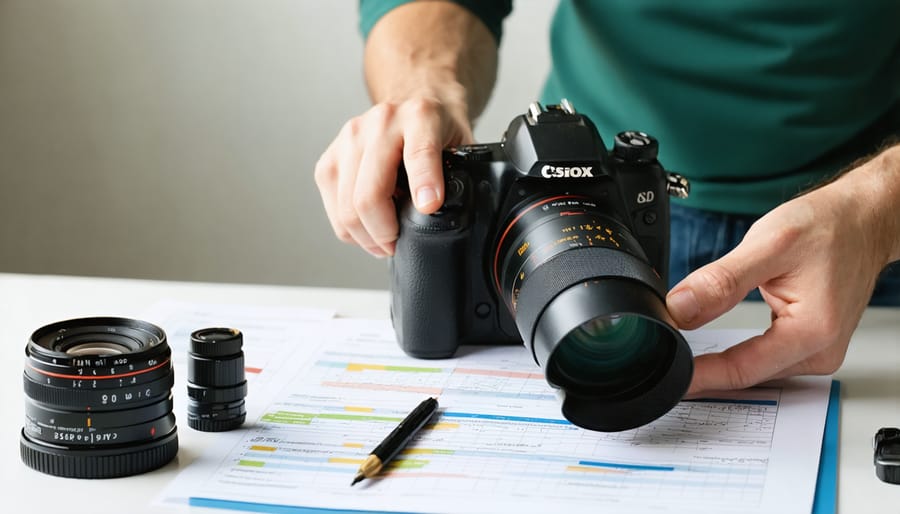
Storage-Specific Care Tips
Different types of photography gear require specific care approaches when in storage. For lenses, always attach both front and rear caps, and store them vertically to prevent stress on the internal elements. Consider using silica gel packets in your storage containers to combat moisture – replace these every six months to maintain their effectiveness.
For camera bodies, remove the battery before long-term storage to prevent potential leakage and corrosion. Keep the body cap firmly attached to protect the sensor area. If you’re storing a DSLR or mirrorless camera with a viewfinder, use a soft cloth to cover it, preventing dust accumulation in those delicate components.
Flash units deserve special attention – remove batteries and store them separately to prevent corrosion. For light modifiers and softboxes, ensure they’re completely dry before storing and keep them unfolded when possible to prevent permanent creases. Following these camera maintenance secrets will significantly extend your equipment’s lifespan.
For filters and smaller accessories, use dedicated cases with individual compartments. Store them flat to prevent warping, and avoid stacking them directly on top of each other. Memory cards should be kept in protective cases away from magnetic fields and extreme temperatures.
Tripods and support gear benefit from periodic cleaning and lubrication of moving parts before storage. Keep them partially extended rather than fully compressed to prevent tension in the locking mechanisms. For bags and cases, store them stuffed with acid-free paper to maintain their shape and absorb any residual moisture.
Proper storage of your photography gear isn’t just about keeping things tidy – it’s an investment in protecting valuable equipment that brings your creative vision to life. Throughout this guide, we’ve explored various storage solutions and best practices that can help extend the life of your gear while keeping it organized and readily accessible.
Remember that the key elements of effective gear storage include maintaining appropriate environmental conditions, implementing reliable organization systems, and establishing regular maintenance routines. Whether you’re working with a dedicated camera room, a modest closet space, or a mobile storage solution, the principles remain the same: protect from moisture, dust, and extreme temperatures while ensuring easy access to frequently used equipment.
Don’t underestimate the importance of proper storage containers and cases – they’re your first line of defense against environmental damage and physical impacts. Regular cleaning, careful handling, and systematic organization will help you maintain your gear in prime condition for years to come.
Consider your storage solution as a dynamic system that can evolve with your growing collection and changing needs. Start with the basics we’ve outlined and adapt them to your specific situation. The time and effort you invest in properly storing your photography equipment will pay dividends in both the longevity of your gear and the efficiency of your workflow.
By following these guidelines and maintaining consistent storage habits, you’ll ensure your valuable photography equipment remains protected, organized, and ready for your next creative endeavor.

